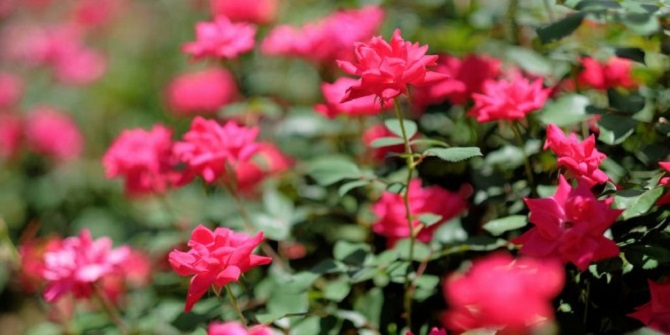Knock Out roses / Alabama Cooperative Extension
Caring for rose bushes doesn’t have to be intimidating, no matter what you’ve heard.
First off, choose good stock; make sure the rose you buy is suited for your location; in other words, if you purchase a climbing rose, do you have a strong support for it to climb? If you are purchasing a Knock Out rose, do you have the space it requires? Or, if you want to grow hybrid teas, or just about any variety of rose, do you have a place that receives, at the very minimum, six hours of sun per day?
Choosing the most well suited site is important to their overall health and vigor of your roses, especially when it comes to watering. Roses require at least an inch of water weekly throughout their growing season, beginning in spring or following spring planting. While overhead watering is suitable before the onset of new growth, it is often better to water these plants at the soil line using soaker hoses or similar means. Rose bushes are very susceptible to fungal diseases, such as black spot and powdery mildew, especially when their foliage is kept too wet.
Use a special fertilizer for roses, applied in spring, following the label instructions carefully. However, with the addition of well-rotted manure, also in the spring, this is usually adequate.
Mulching your rose bush will help retain moisture and may also offer some winter protection. Be extremely careful that when you mulch you don’t cover the knotty looking growth near the bottom of the trunk of the bush. This is the graft union, and your rose will revert back to one of its parents if that is ever covered.
Pruning is another aspect to consider when caring for rose bushes. This often takes place once leaf buds appear in spring. Make cuts about a quarter inch above the bud eyes and prune out any twiggy or unhealthy branches. But you can actually prune a rose at any time. If you see that it is in distress right now due to the heat, cut it back! You can cut it back to one-third of its size and it won’t hurt it one bit, in fact, you are saving it from having to use so much energy by taking that much off of it. It will be better able to withstand drought conditions, as well.
Prune your roses by looking for the outward facing buds, make your cut just above that bud and you will have a better-looking rosebush; make it with the bud facing inward and you’ll have a zigzagging confused looking bush.
When pruning take out all dead wood. Pruning is a great time to check your rose for insects. You might notice a small, white, cottony substance; these are mealy bugs. If you see white, powdery looking foliage, that’s a fungus, mainly caused by humidity and water standing on the leaves. You can purchase one product that will help with diseases, fungus and insects. Look for products that list all three.
Here’s a tip to keep cut flowers fresher: Drop one quarter teaspoon of bleach for each quart of vase water to ensure the water stays clear and free of that nasty smell that starts to brew about a week after the flowers bloom. You’re supposed to change the vase water every day, but anyone who has time for that deserves a medal or probably doesn’t have kids.
Copyright 2017 Humble Roots, LLC. All Rights Reserved.






























